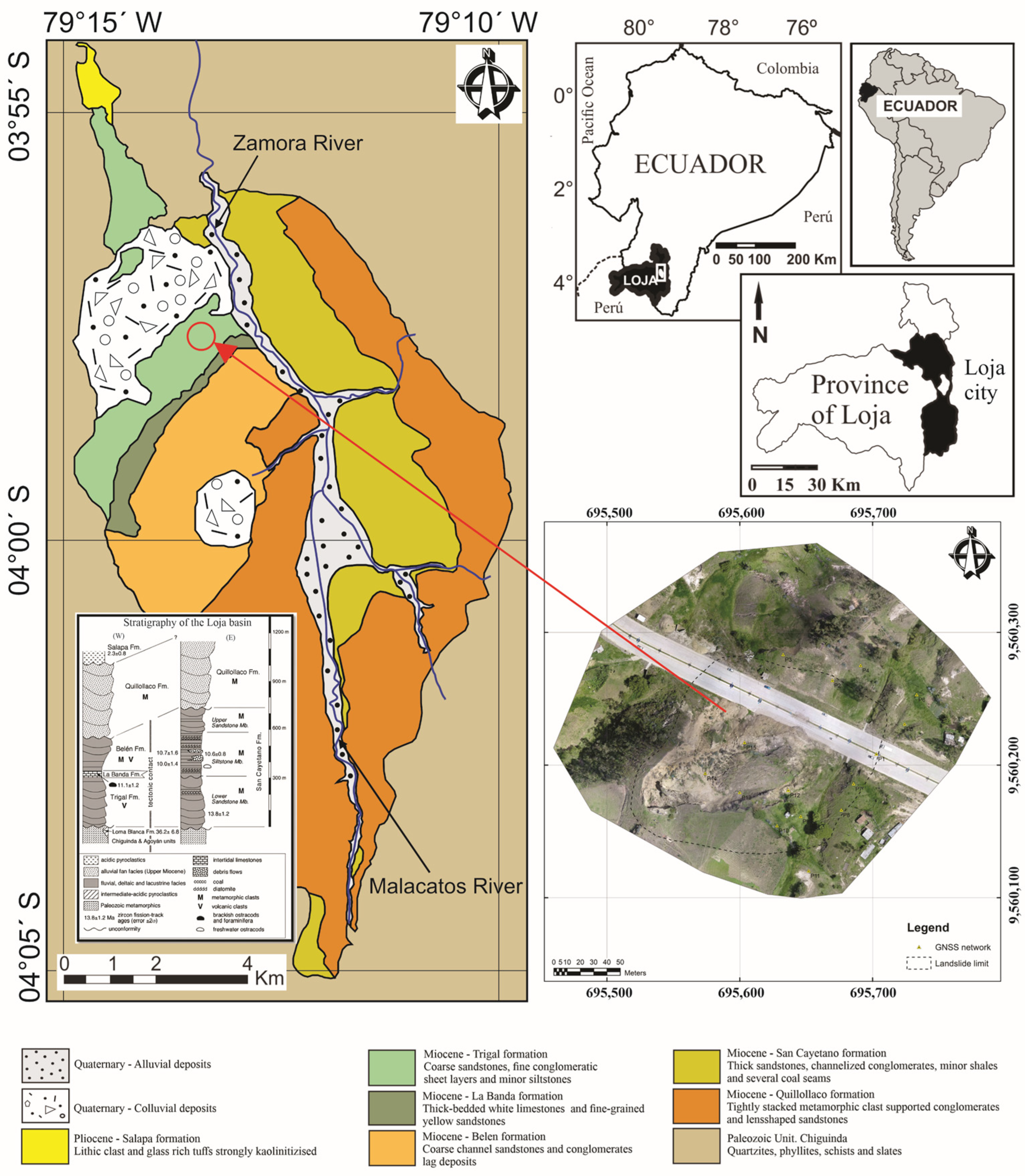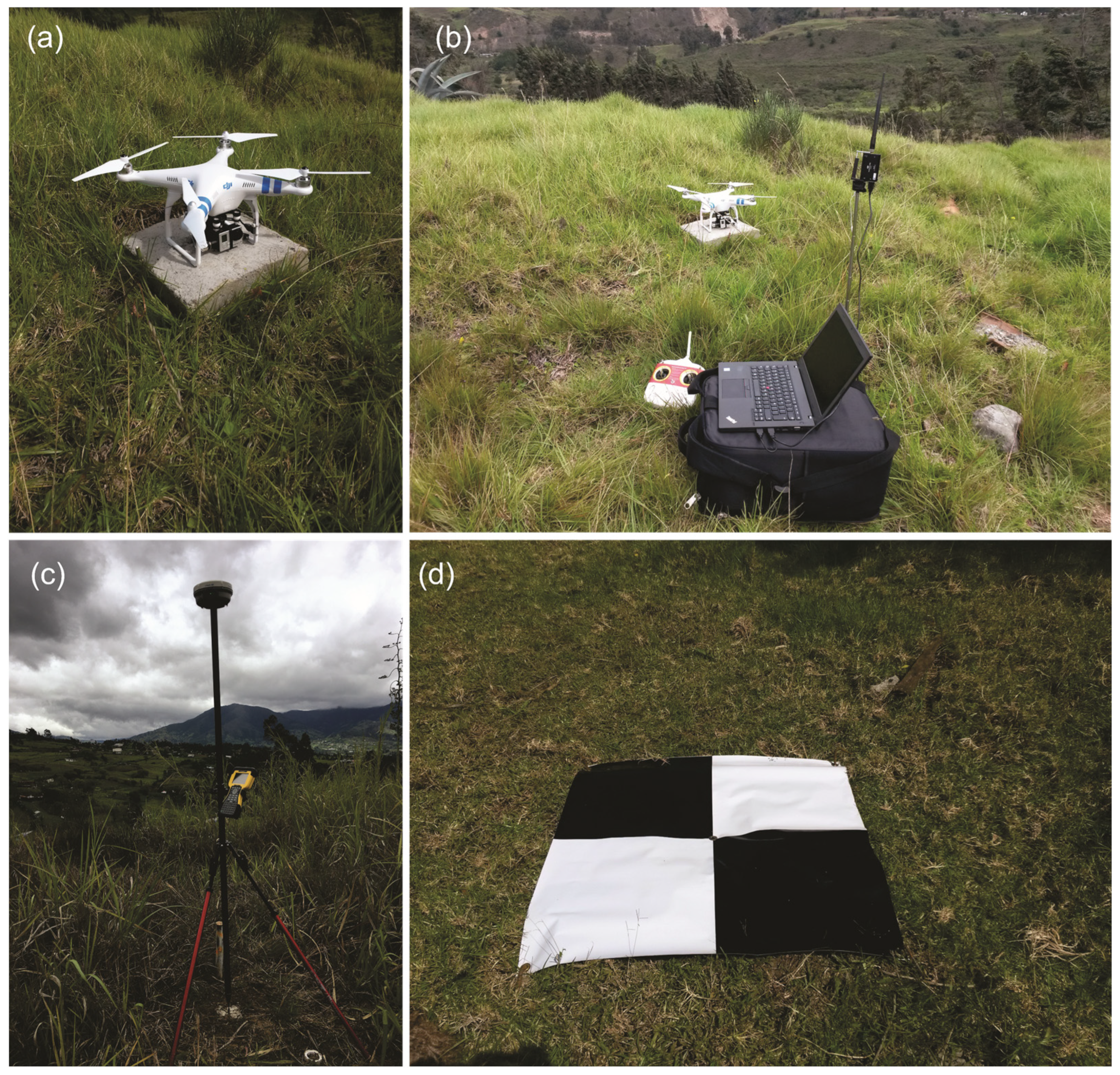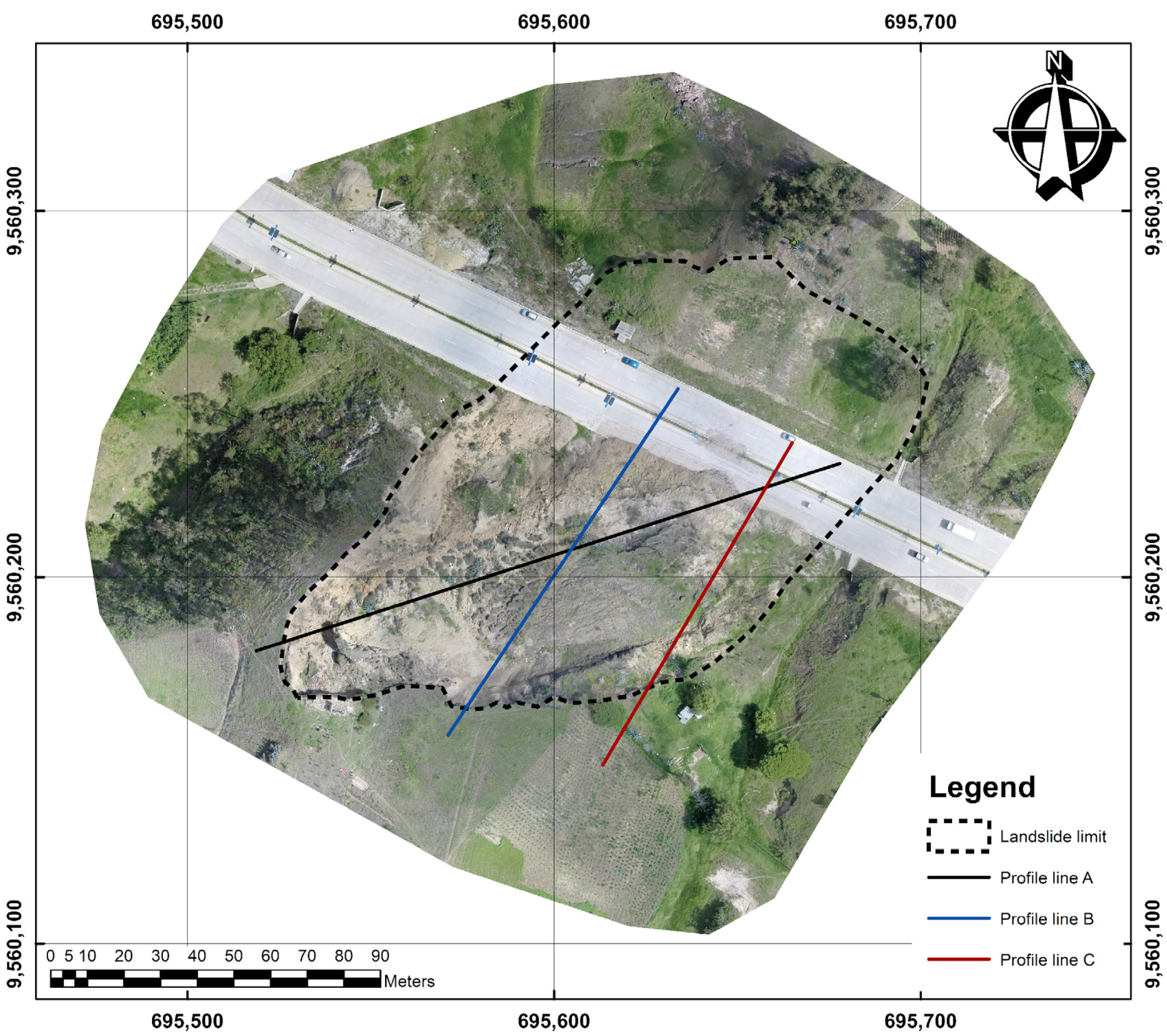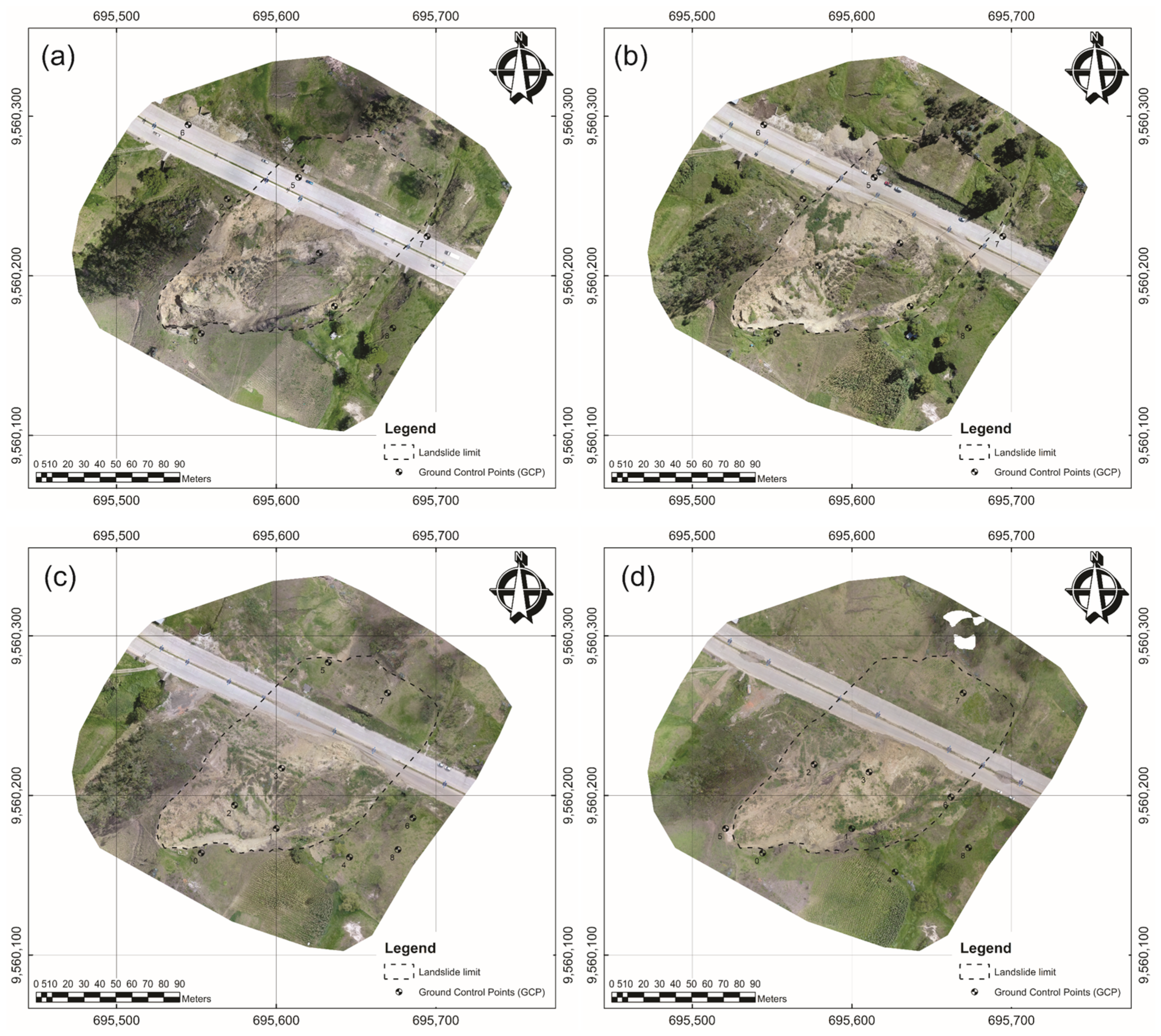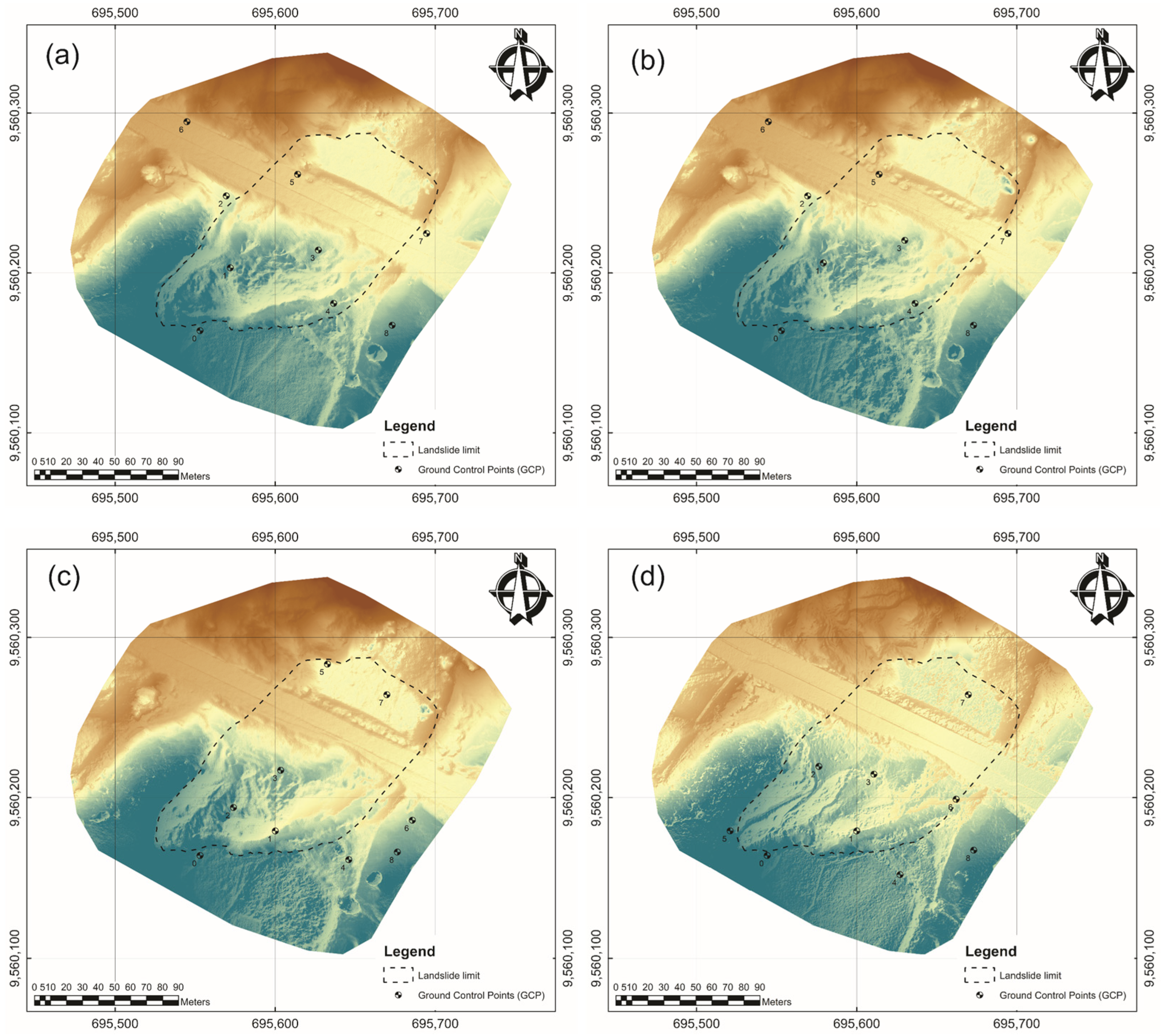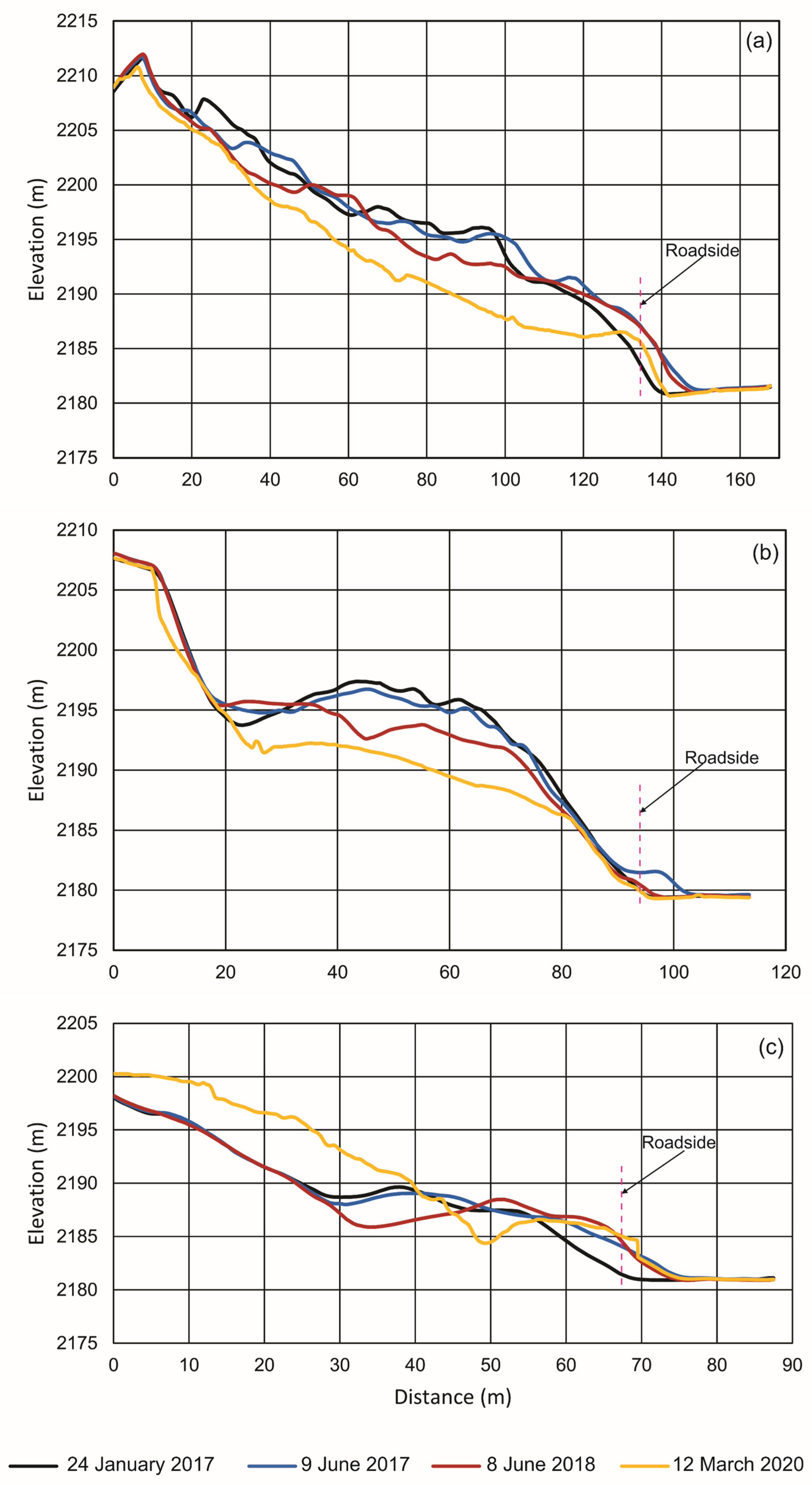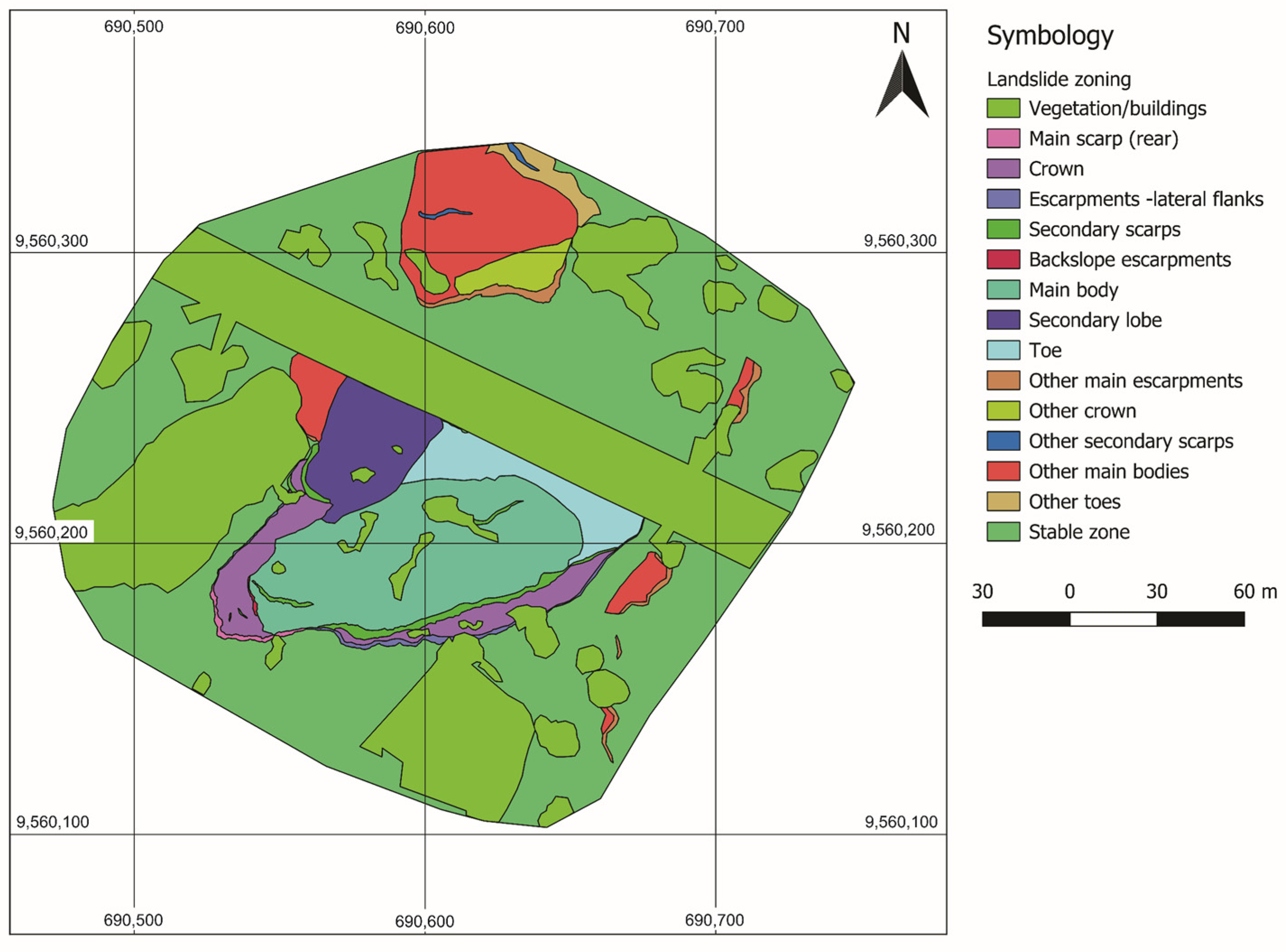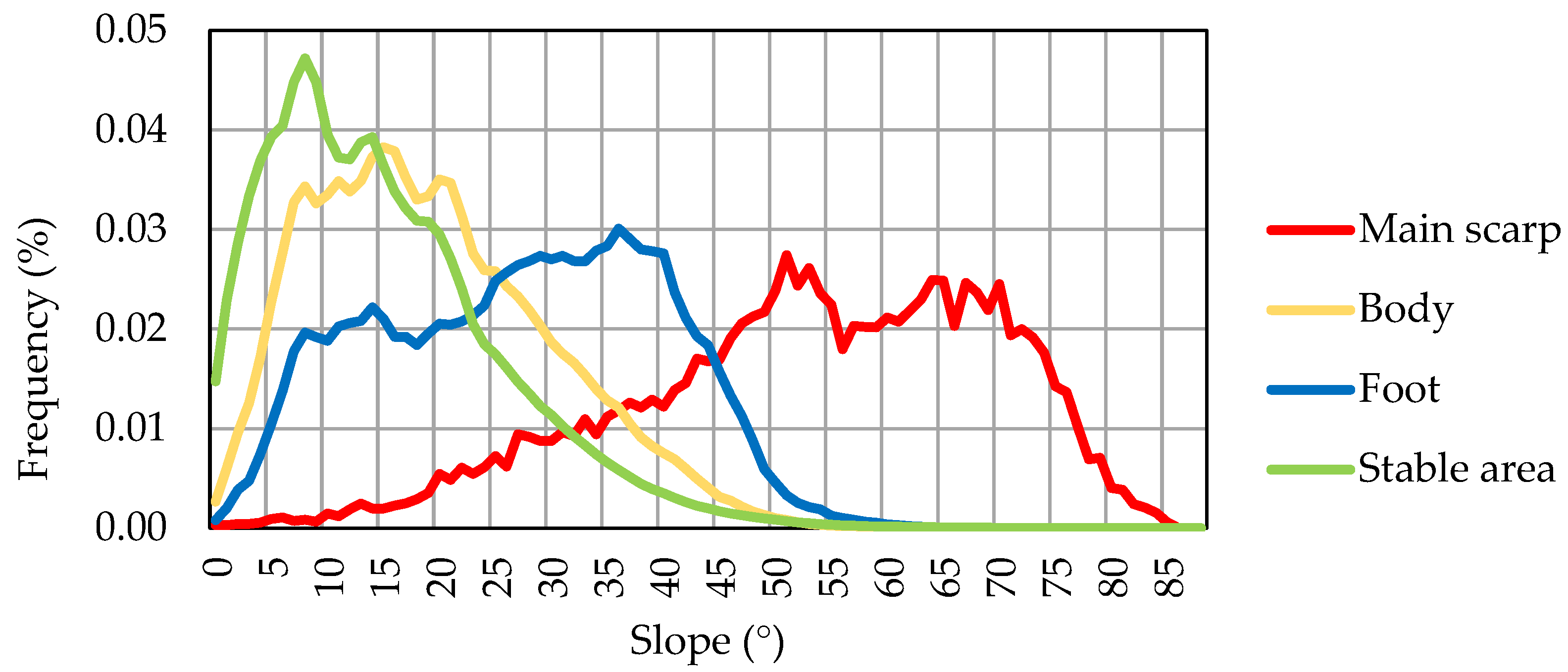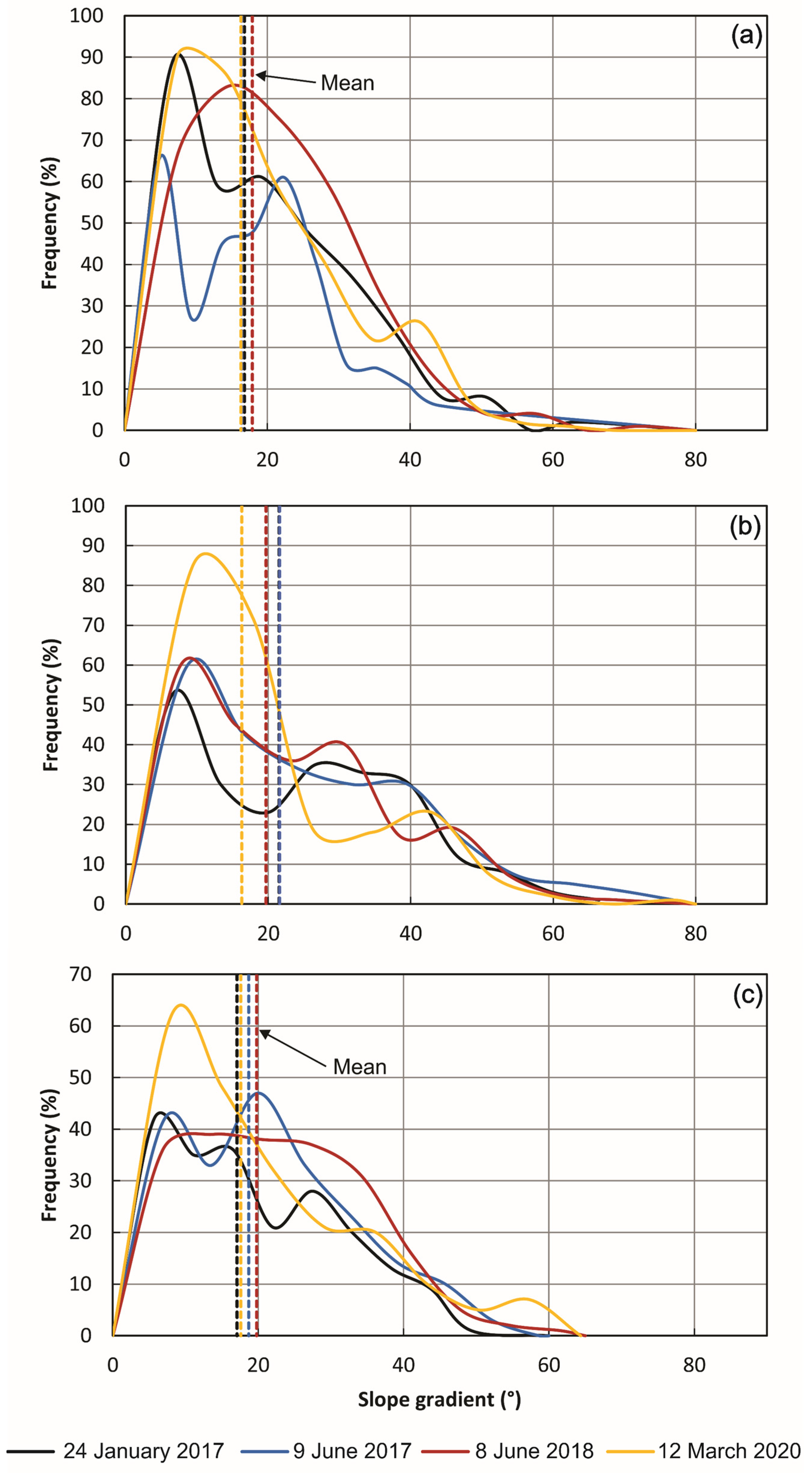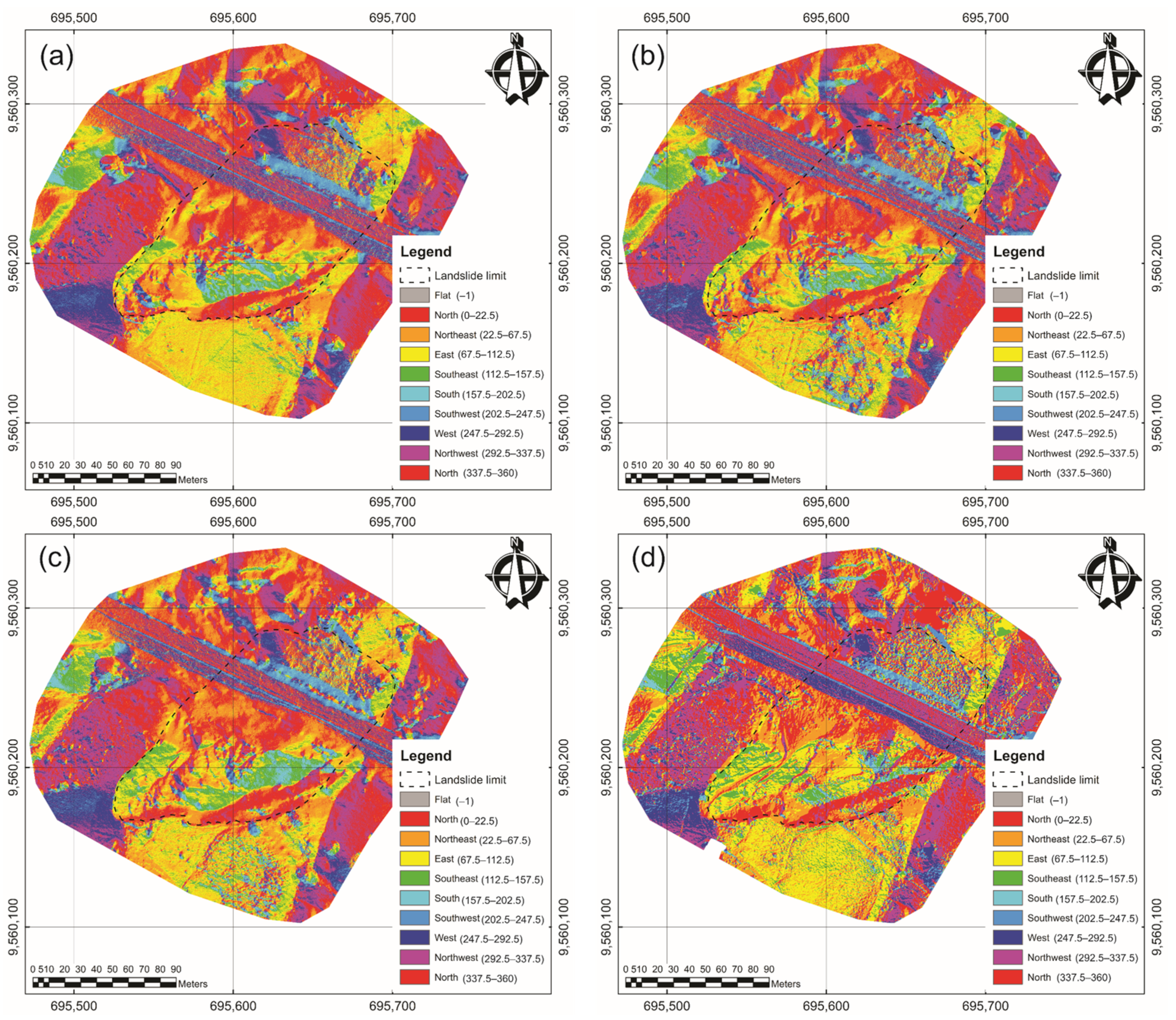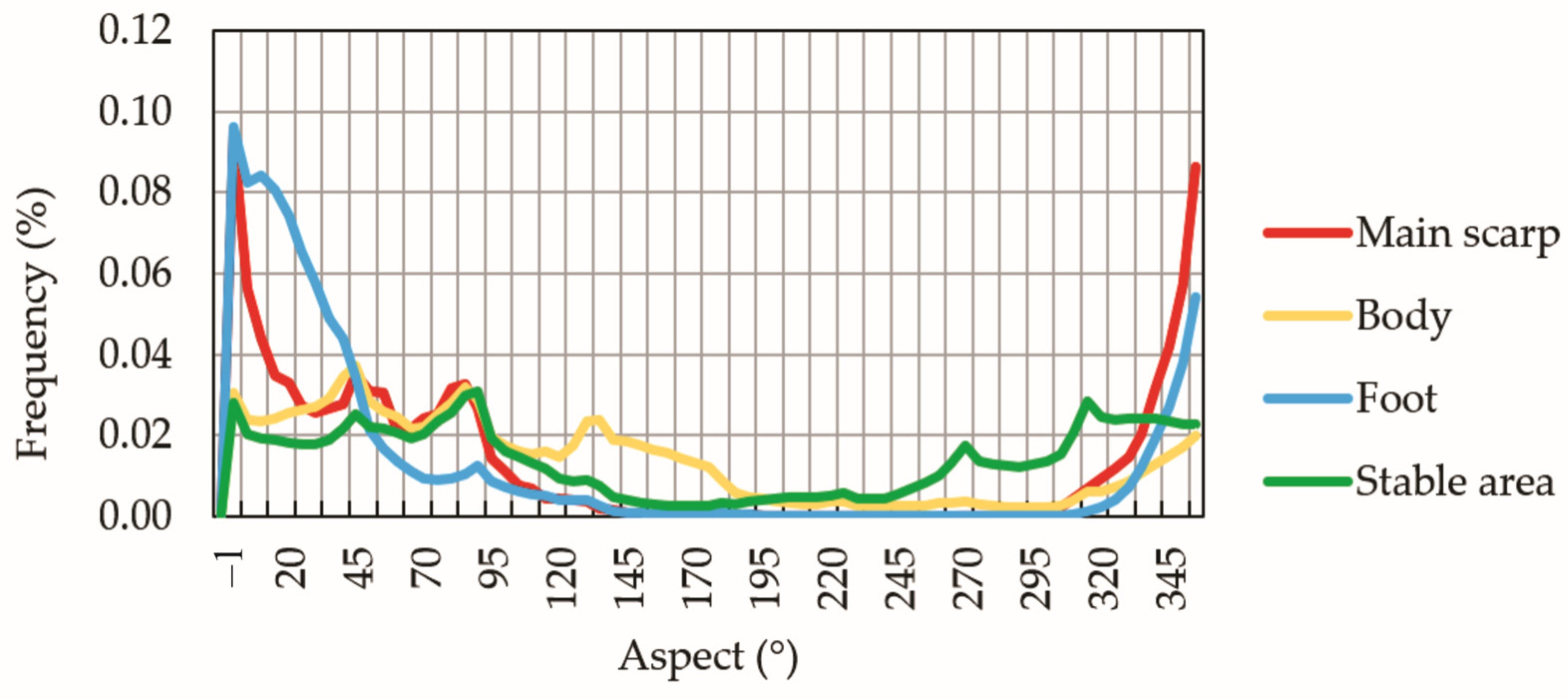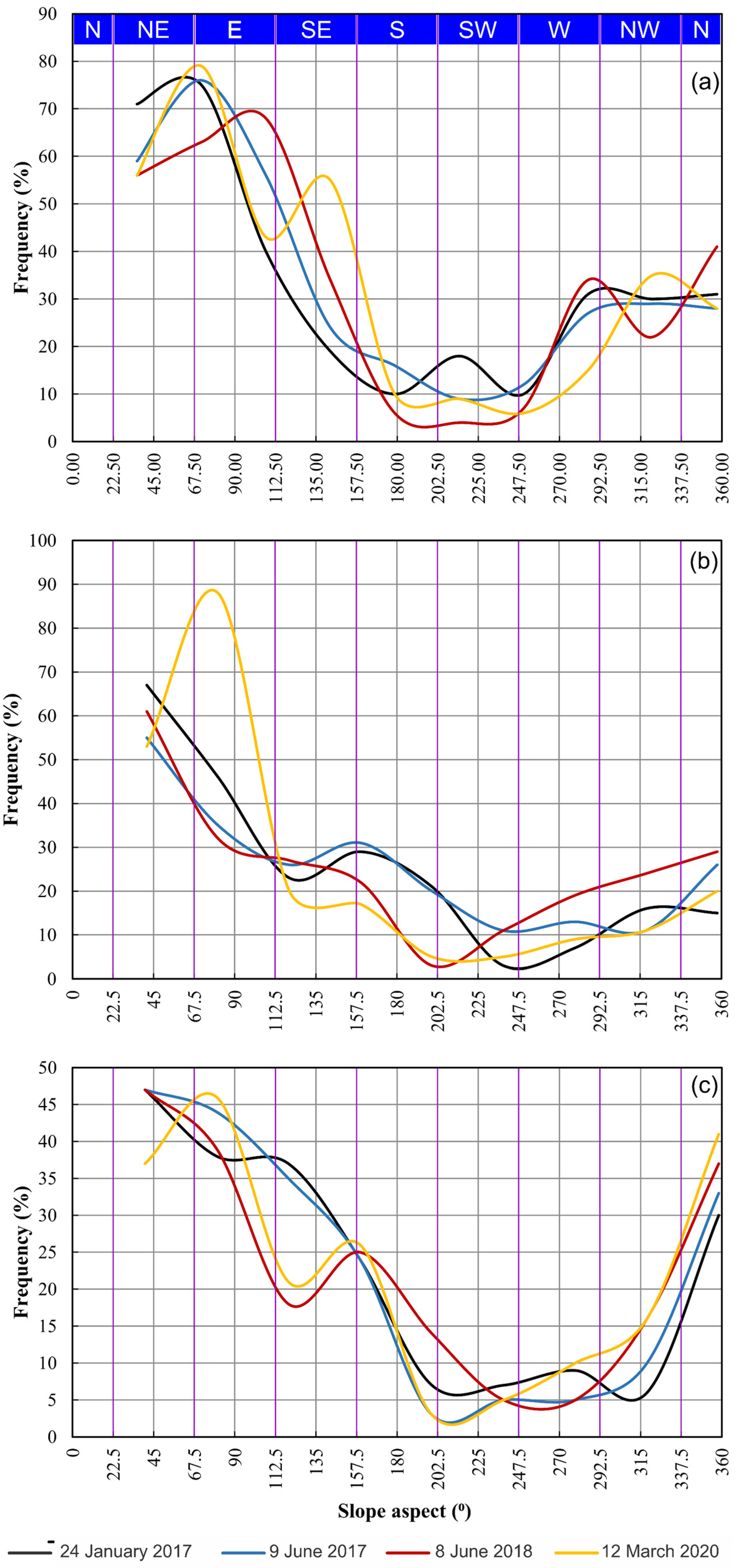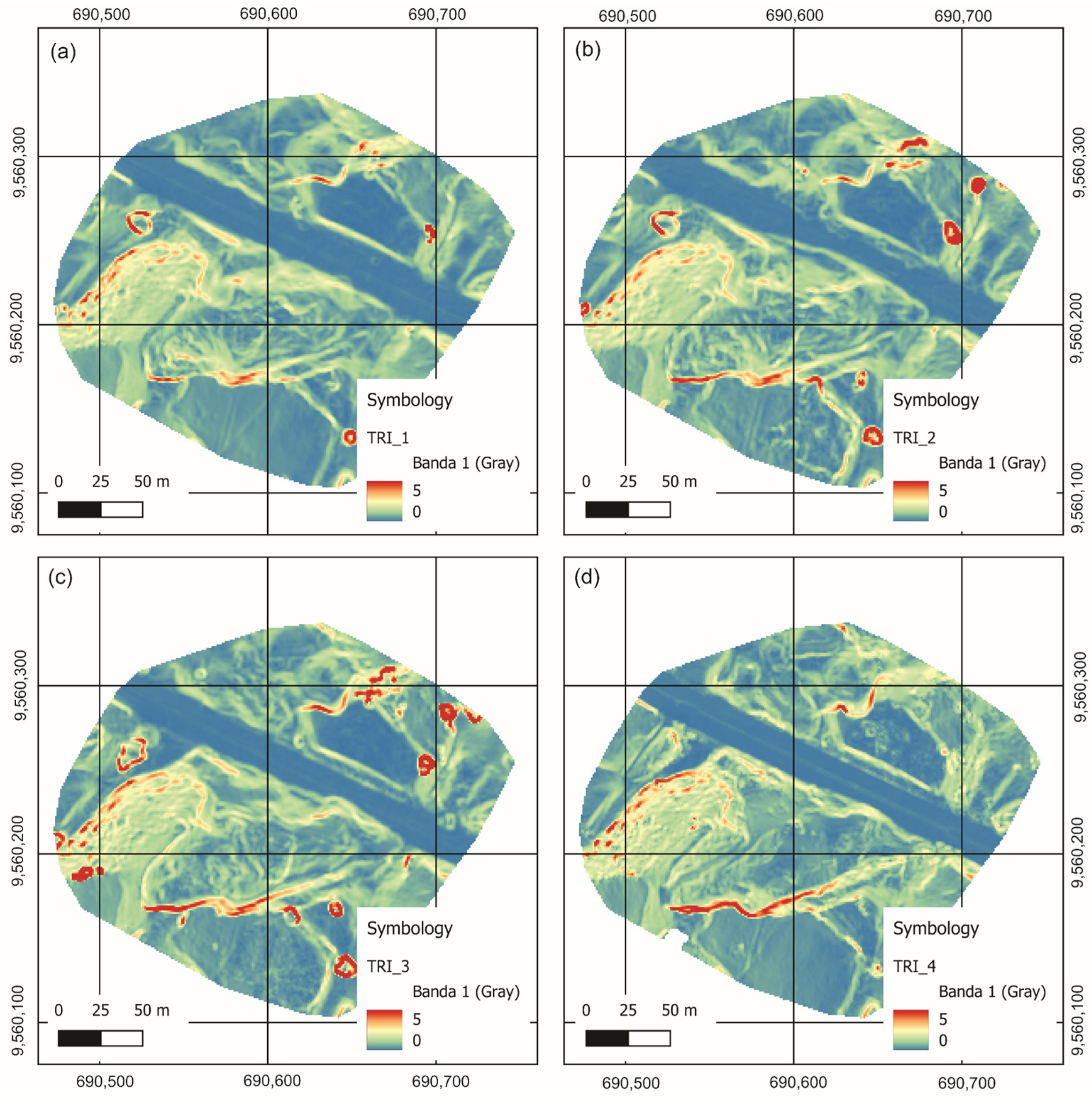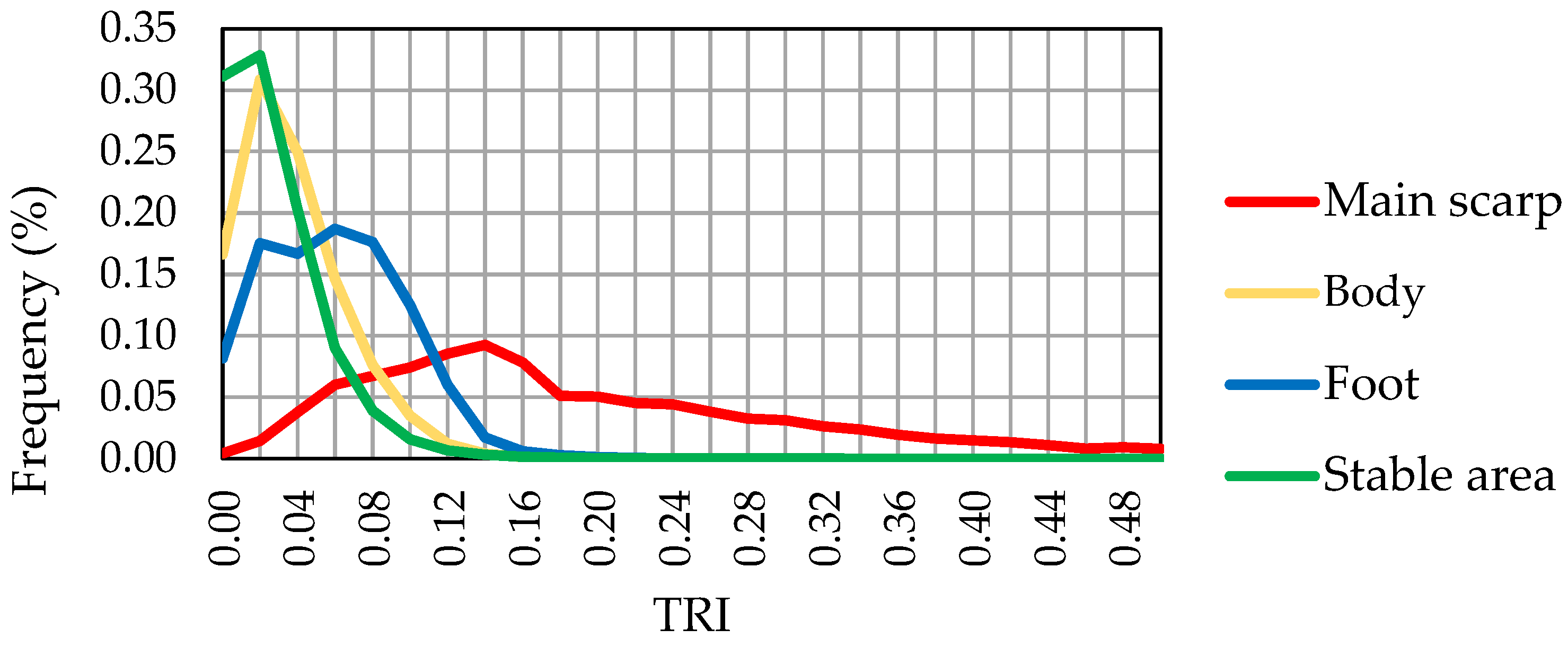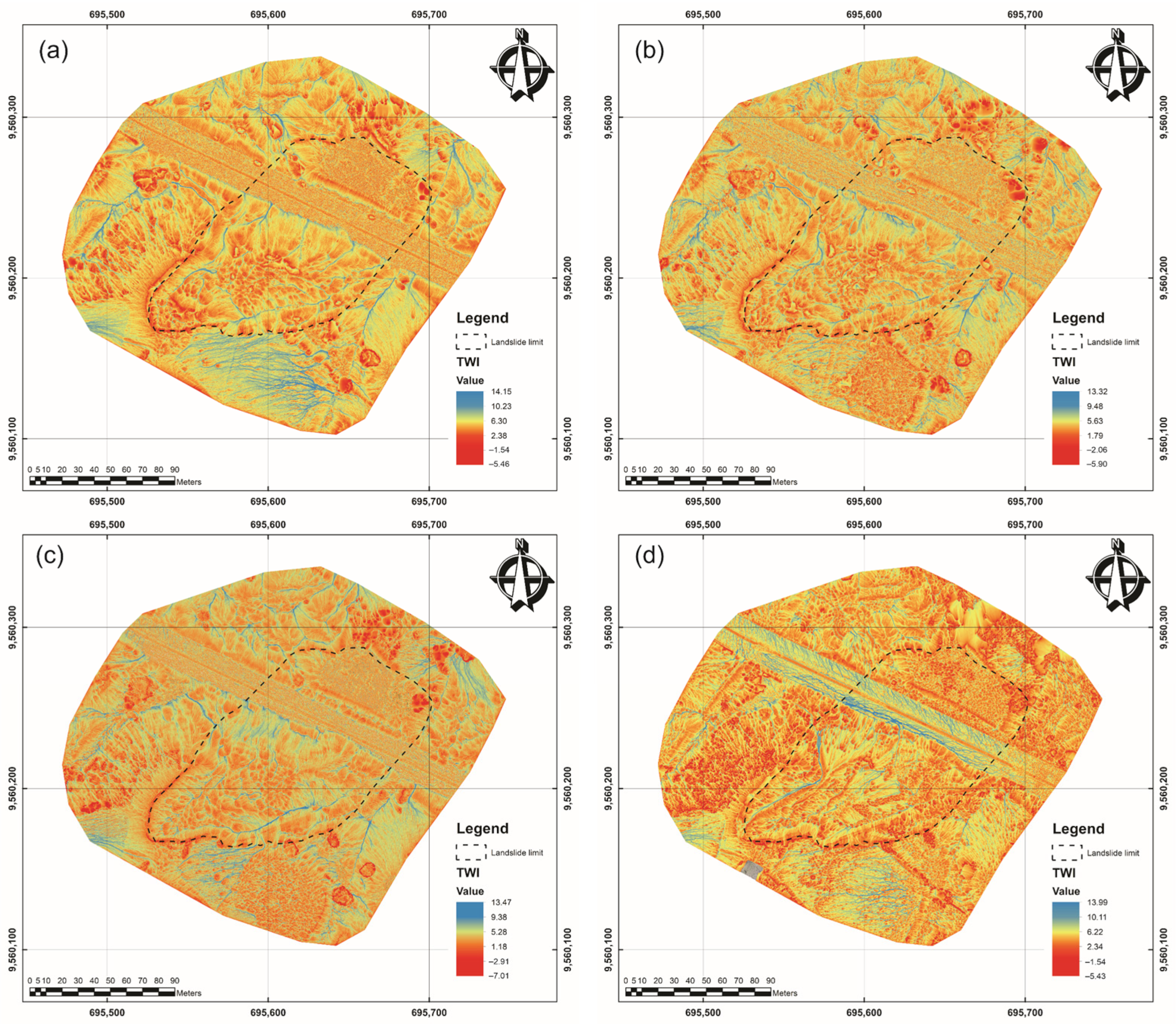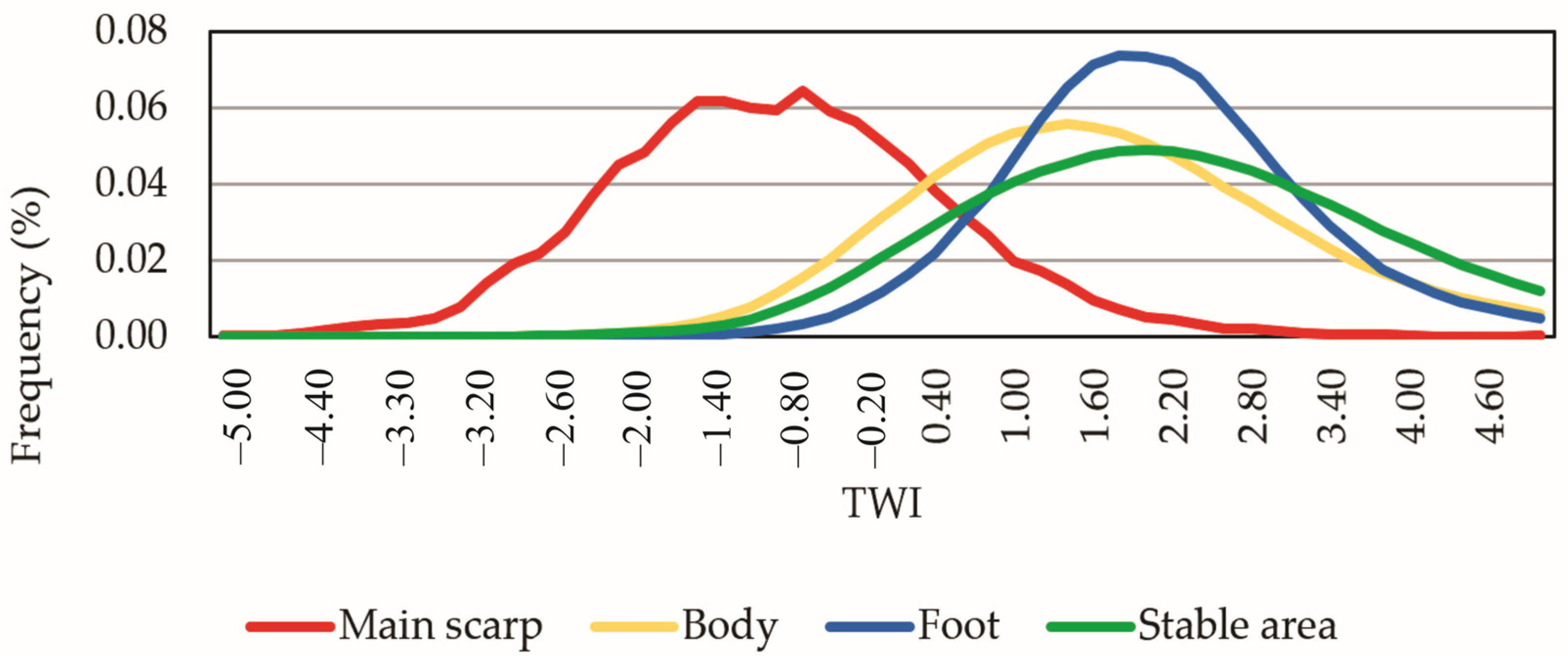1. Introduction
The study of landslides is of vital importance to understand and mitigate the risks associated with natural phenomena as well as to promote the sustainable development of affected areas. Understanding the characterization and analysis of the evolution of landslides plays a fundamental role in the Sustainable Development Goals, because it allows an adequate management of natural resources, more efficient territorial planning, and protection of the communities that inhabit areas prone to landslides [
1,
2,
3,
4]. Understanding the characterization and analysis of landslide evolution can significantly contribute to the Sustainable Development Goals in several ways:
Disaster risk management: Understanding the characterization of landslides and their evolution makes it possible to identify landslide-prone areas and assess the associated risk. This facilitates the implementation of adequate prevention and mitigation measures to reduce the exposure of communities to landslides [
5,
6]. By minimizing the risks of natural disasters, both people and the natural environment are protected, contributing to long-term sustainability.
Sustainable urban planning: Analysis of the evolution of landslides helps to understand how human activities can contribute to their occurrence. This is especially relevant in the context of urban planning, where the growth of cities can increase the pressure on slopes and unstable terrain [
7,
8]. By taking this information into account, regulations and development guidelines can be established to avoid construction in areas of high landslide risk, thus promoting more sustainable urban planning.
Ecosystem conservation: Landslides can have a significant impact on ecosystems, altering soils, vegetation, and local hydrology. Understanding the characterization of landslides and their evolution makes it possible to identify the factors that contribute to their appearance, such as deforestation or soil degradation [
9]. By taking steps to preserve and restore natural ecosystems, you can strengthen the resilience of vulnerable areas to landslides and promote environmental sustainability.
Natural resource management: Landslides can impact the availability and quality of natural resources such as water and fertile soil. Through the characterization and analysis of landslides, it is possible to understand how these processes affect natural resources and take measures for their sustainable management. For example, soil and water conservation practices can be implemented to reduce erosion and prevent landslides, thus ensuring the availability of essential resources for future generations. To study natural hazards, specifically landslides, it is necessary to have techniques and procedures that provide information on terrain evolution with sufficient spatial and temporal resolution [
10,
11,
12,
13,
14,
15] to determine geomorphic changes. Currently, Global Navigation Satellite Systems (GNSS) [
16,
17,
18,
19,
20] and Terrestrial Laser Scanning (TLS) are commonly used, which provide high-density point clouds and high-quality digital elevation models [
21]. However, these techniques require significant processing time and are costly. In this context, the use of remotely piloted aerial systems (RPAS), also known as drones, represents a low-cost alternative [
22,
23,
24] that enables the acquisition of high-resolution aerial imagery for mapping and monitoring small-scale areas [
5,
25,
26,
27].
The use of RPAS in the study of landslides has allowed for the evaluation of their kinematic behavior and temporal evolution [
5,
25,
26,
28,
29,
30]. This is achieved through the acquisition of photogrammetric products derived from precise processing, enabling measurements that can even detect small-scale terrain changes. Structure from Motion (SfM) algorithms are employed for images orientation [
31,
32,
33,
34] providing accuracies of about 0.10 m from which photogrammetric products such as DEMs and orthoimages are obtained. The former are usually compared by means of DEM of differences (DoDs) and the latter are used for interpretation and digital image correlation (DIC) [
25,
26,
27,
35,
36,
37,
38,
39,
40,
41,
42,
43,
44,
45]. The accuracy of photogrammetric products largely depends on the number and distribution of ground control points (GCPs) and checkpoints (CHK) measured using GNSS techniques [
16,
25,
38,
46,
47], which enable model orientation [
17]. Additionally, geodetic measurements [
45] using GNSS techniques provide high-precision coordinate estimation, making them valuable for monitoring surfaces undergoing both slow and rapid deformations at different scales [
48].
The geomorphometric approach [
49] is employed to analyze the morphology of the terrain based on high-resolution digital elevation models (DEMs) derived from LiDAR systems or through RPAS photogrammetry, which allows for the detection of subtle changes in the topography. This information can be used to generate maps of slope, aspect, curvature and roughness, among others, which help to characterize landslides, identify their elements, and understand the kinematics and dynamics of the slope [
50,
51,
52,
53,
54].
Recent findings regarding landslides in Ecuador have significant implications for the understanding and management of this natural phenomenon. These discoveries allowed for a greater understanding of the determinant and triggering factors of landslides, such as topography, geology, seismic activity, and weather conditions. In addition, they have made it possible to identify areas prone to this type of event [
55,
56], which contributes to better urban and rural planning, as well as the implementation of preventive and adequate mitigation measures. These findings have also improved the ability to monitor land changes in landslides areas based on classical approaches such as photointerpretation, DoDs calculation and point extraction and measurement [
57], which is essential to alert communities at risk and take timely measures to ensure the safety of the population. However, other approaches are required such as DIC for a better measurement of displacements; object-based analysis (OBIA) for features identification; and morphometric analysis, the approach implemented in this work, for landslide and terrain characterization. In general, scientific advances in this field are strengthening Ecuador’s resilience against landslides and require a solid foundation for the development of effective natural risk management strategies.
Thus, the main objectives of this study are: (a) the characterization of the landslide, identifying its elements and describing its morphology; and (b) the monitoring of its kinematics. For it, we have analyzed not only the direct photogrammetric products such as DEM and orthoimages but also topographic or morphometric parameters and their changes. The detailed and systematic analysis of these parameters is the main contribution of this study, which has allowed precise landslide characterization and monitoring. Previous works have focused on some parameters such as slope [
52,
53], aspect [
53], curvature [
51,
52,
53,
54], roughness [
50,
53] or TWI [
50], but none have examined all of them and even less with a multitemporal approach that allows landslide monitoring.
Thus, multitemporal RPAS flights were captured in a landslide in the El Plateado sector of the city of Loja, Ecuador. One of the main advantages of RPAS is their capability to fly at altitudes below 100 m, allowing for the integration of new sensors on aerial platforms. RPAS can capture images from various angles, provide flexibility in conducting work at different scales, offer cost-effective solutions, and deliver high-quality results [
15,
16,
17,
18]. RPAS technology has been successfully used for the cartography and monitoring of areas spanning few square kilometers.
The scheduled flights allowed for the acquisition of images, which once processed, produced orthoimages and DEMs. For this purpose, the photogrammetric image blocks were oriented using SfM techniques with the support of ground control points whose positions were determined using differential GNSS. The interpretation of the orthoimages has allowed the observation of morphological features and changes in land cover and elements affected by the landslide. Moreover, from DEMs, longitudinal profiles, DEMs of differences (DoDs), and especially detailed maps of morphometric parameters derived from DEMs such as slope, aspect, TPI, TRI, and TWI were obtained. These models have enabled the detection of morphologies that contribute to the characterization of landslides in the study area, and furthermore, due to their multitemporal nature, the analysis of their temporal evolution.
4. Discussion
4.1. Accuracy and Uncertainty of DEMs and Orthoimages
Considering the root mean square errors (RMSE) at the checkpoint (CHK) locations shown in
Table 1, it can be observed that the horizontal errors (XY) range from 0.025 to 0.041 m through the different flights, which is even lower than those found in GCPs (0.035–0.053), and they are always below the 0.05 m resolution of the orthoimages and DEMs. Both these values and those calculated for the control points are similar to the errors obtained by other authors in RPAS surveys under comparable conditions [
25,
26,
30,
34,
38,
57,
91,
92]. Therefore, the uncertainty for horizontal measurements is established at 0.05 m.
Regarding vertical RMSE (Z), the obtained values vary from 0.025 to 0.041 m with an average of 0.030 m, which is similar to the average error obtained at GCPs (0.023–0.034 m). According to previous studies [
26,
27,
67], the uncertainty of the DEMs is estimated to be two to three times the value of these errors, which amounts to approximately 0.10 m. Meanwhile, the vertical uncertainty of the DoDs, also known as the minimum level of detection (minLoD), is estimated as [
23,
26,
46,
93,
94,
95,
96]:
Thus, based on the overall uncertainty of DEMs, the uncertainty of DoDs can be stated in 0.15 m.
In both cases, the displacements of metric order, both horizontal and vertical, caused by the landslide in the study area far exceed these uncertainty thresholds, suggesting that the models and orthophotos have more than sufficient quality for this study.
4.2. Detection of Elements through Photointerpretation and Semiautomatic Extraction
The detection and mapping of terrain features, specifically those related to the landslide, have been carried out through both photointerpretation and semiautomatic extraction using orthoimages, DEMs, and derived models.
Photointerpretation of the orthoimages has allowed for the identification, delineation and digitization of several features and elements of the main landslide, such as different types of scarps (main, lateral, secondary and counterslope), crown and head, body and foot. Other areas of instability and their corresponding elements as well as areas with vegetation and structures have also been identified and mapped to exclude them from subsequent analyses. The identification of features and elements has followed the classic guidelines of photointerpretation primarily involving the analysis of color (RGB images), including shadows, and texture analysis.
However, this identification and mapping of elements has also relied on the observation of DEMs, especially the derived models. There are many works based on topographic parameters carried out at different resolutions, from models corresponding to aerial LiDAR [
51,
53] to models obtained with RPAS images [
52,
53,
54]. Thus, the slope model, for instance, provides a good approximation for identifying different types of scarps in steep areas (greater than 30°−45°), but it is also useful for identifying other landslide elements such as the foot, with slope contrasting to the body or the stable zone where the slope is gentler.
Meanwhile, aspect or orientation allows us to observe some features such as scarps or lobes; thus, the scarps in some cases interrupt the general orientation of the slope, such as the right lateral scarp that has a N orientation within a slope exposed to the ESE. Within the landslide body, the lobed surface of a flow-type movement can be seen oriented to the N on the left part and SE on the right part, suggesting an ENE axis as the direction of advance of the landslide. In this area, counterslope scarps (WNW) are also very visible.
The TPI makes it possible to clearly delimit scarps and other elements such as the toe or tip of the foot where slope breaks occur. Thus, the skeletonization of the zones with high absolute values (positive and negative) of the index leads to quite clearly identifying the lines corresponding to the upper and lower edge of the scarps, respectively. This index and the curvature, which are usually closely related, have been used in previous works for detecting landslide scarps [
51,
53,
54,
81]. In scarps, the slope breaks are very pronounced, so they are well detected in the very high-resolution models (0.05 m) as well as in the high-resolution models (1 m), although they are logically more precisely in the former. However, other elements such as the foot and more specifically the toe, in which the break is less pronounced, are better extracted with models of 1 m resolution.
The roughness also allows the identification of scarps in a very similar way to the slope, but it does not provide any significant improvement with respect to it, so it is not analyzed in detail in this work. Finally, the TWI makes it possible to identify the hillslope areas where there is a great potential to accumulate or circulate water mainly from rain and runoff. Thus, the drainage network of the hillslope is somehow represented, and its higher or lower development and hierarchical order are analyzed. It can be seen that in the upper part of the landslide, the values are low and increase in the body until reaching higher values (water accumulation) at the foot next to the road. The formation of drainage channels on the flanks can also be seen. The relationship of this index with the soil and its incidence on the stability of the landslide are discussed later.
4.3. Morphometric Analysis
The morphometric analysis makes it possible to characterize in a quantitative way the different landslide elements and distinguish them from the stable area of the hillslopes based on the statistical values obtained for each of the parameters considered.
Thus, the scarps are one of the elements that are best characterized as they present high slopes and roughness. Slope present average values greater than 40°, and even 50° in the main scarp, which allows this parameter to be used for detecting areas that can eventually be mapped as scarps. Meanwhile, the average slope of the landslide is about 24°, more than 8° higher than that of the stable zone, which is consistent with the fact that the slope, together with roughness, is a determining factor in stability and susceptibility analyses both probabilistic and deterministic [
97]. Furthermore, this slope is characteristic of slide-flow type movements such as the one studied [
98]. For the remaining elements, the main body barely reaches an average slope of 20°, the head of 23°, and the foot of almost 28°.
The aspect logically does not show characteristic values as the slope angle, but it does allow distinguishing elements of the landslide regarding the overall hillslope. Thus, in a sequence of hillslopes oriented to the NW and SE, the landslide shows an orientation with a greater N component (NE in the body and NE in the foot). There are also areas with an orientation contrary to the general one, corresponding to counterslope scarps.
The TPI average values are very uniform across all considered elements; in this case, the statistical measure that marks the differences is the standard deviation, which is significantly lower in the stable zone but increases noticeably in the landslide area, especially in the scarp but also in the foot. In the scarps, although the mean value is always close to 0 due to the compensation of positive curvature (upper limit) and negative curvature (lower zone), the absolute values and consequently the standard deviation are higher than in the stable zone, where they are always close to 0.
The TRI exhibits a distribution similar to the slope, with the highest values found in the scarp zones (0.14), particularly on the main scarp (0.22). Meanwhile, the head area shows an average roughness value of 0.06, which is slightly higher than the body (0.05) and lower than the foot (0.07). The other instability zones also present higher values in the scarps compared to the other elements, although these are slightly lower. In both cases, the average roughness values are always higher than in the stable zone (0.04).
Finally, the TWI within the landslide area shows increasing values from the head to the foot where the highest values are reached, indicating water concentration in the foot and road area, which can promote instability in this part and the overall movement. However, it is interesting to note that the mean TWI value is lower in the sliding zone and other unstable areas compared to the stable zone, which may be attributed to the disorganization of the hydrographic network within the landslides areas.
4.4. Landslide Evolution and Kinematics
The analysis of the landslide evolution has been carried out using various techniques: photointerpretation, observation of DEM of differences and derived model maps, topographic and parameter profiles, and the break lines extracted from TPI. Based on these analyses and the obtained results, areas of depletion and accumulation of material can be identified in the head and foot, respectively, resulting from the landslide kinematics. In summary, the following observations can be made regarding landslide evolution:
The landslide had already developed before the start of the monitoring campaigns with RPAS flights (24 January 2017), as clearly seen in the maps, profiles, and lines extracted from the TPI maps, showing a well-formed main scarp and various secondary scarps along the mass body. The body appeared individualized with a lobed shape and an ENE direction axis, as indicated by the aspect map discussed previously, ending in a foot that progressed in a direction with a greater N component due to the presence of the road. The TWI allows for the observation of two drainage channels formed close to the two-lateral flanks and a more irregular and less hierarchical drainage network within the landslide. The average initial slope in the landslide area was 24°, calculated from the total area, and 18–22° in the two most significant profiles (longitudinal and oblique-centered). This can be explained by the fact that the profiles include part of the terrain on the crown and the road beneath the toe. The frequency of slopes less than 20° was 60% in profile A and 46% in profile B.
In the next two dates (flights on 9 June 2017 and 8 June 2018), an advancement of the landslide mass could be observed, which can be estimated from the secondary and counterslope scarps observed in the DoDs and derived models (slopes, aspect, TPI, and TRI) but especially in the topographic profiles. In the longitudinal profile (A), mass descents of approximately 6–8 m and advancements of around 20–25 m were estimated in the head area and upper part of the body, which were distributed almost equally in each period. These results lead to an average velocity approximately twice as high in the first period (descent of about 1 m/month and advancement of about 4–5 m/month) compared to the second period (0.5 m/month and 2–2.5 m/month, respectively). In the foot and toe, the mass advanced about 5–6 m, mostly occurring in the first period with an estimated velocity of around 1 m/month, although it may be underestimated due to material removal in the road area. The other profiles of a transversal nature allow for estimating a descent of about 3–5 m and an advancement of about 6–8 m in the toe area, which were also higher in the first period. The slope gradually decreased in both dates in profiles A and B, as a result of the landslide advancement and material evacuation, while profile C shows a more irregular evolution due to its marginal position in the landslide. Meanwhile, the percentages of slopes exceeding 20% increase up to 65% in profile A and up to 52% in profile B.
In the last date (12 March 2020), a much flatter shape of the slope was clearly observed, with material removal from the body and foot, although the slope above the road was still present. The secondary scarps and counterslopes disappeared, as observed in the aspect models, and the overall morphology of the body was smoothed, with a descent of the surface that became progressively greater toward the lower part of the body and the foot, reaching about 5 m compared to the third date and about 8 m compared to the first date. The slope angle clearly decreased compared to the previous dates, especially in the longitudinal profile (from 17° to 13°). The percentage of slopes less than 20° increased to 76% in profile A and 64% in profile B.
Details about the evolution of the landslide, such as the formation of scarps and the development of the foot, can also be deduced from the models and profiles. In this case, the most appropriate analysis is the comparison of break lines extracted from the TPI, both the 0.05 m resolution for the scarps and the 1 m resolution for the toe (specifically the tip). Thus, the retreat of the main and lateral scarps of about 2–3 m can be observed (
Figure 24a), irregularly distributed (more in some sectors and less in others) between the first date (24 January 2017) and the third date (8 June 2018). Regarding the toe, advancements of about 5 m were observed between the first and third dates (
Figure 24b). This generally coincides with what is observed in the profiles.
Therefore, the use of DEM with centimetric resolutions allows the detailed representation of the topographic changes caused by landslides, so it is feasible to detect changes in some topographic parameters such as the slope, aspect, TRI and TWI.
4.5. Relationship between TWI and Soil Characteristics
Landslides occur when, in addition to the slope intrinsic factors or instability determinants (such as lithology, slope, morphology, and vegetation cover), other triggering external factors come into play, including rainfall [
25,
99,
100,
101,
102], earthquakes [
70], anthropogenic factors [
80], etc. However, in this case, rainfall is the main factor that affects landslide processes, as established in the region surrounding the study area, where rainfall thresholds triggering landslides have been determined [
103]. A superficial exploration of the terrain reveals the presence of well-identified cracks and jumps at the head (
Figure 1b,c).
Analyzing the TWI maps, it is clear that blue shades represent areas of water accumulation or circulation, which are concentrated in the lower part of the body and the foot of the landslide, particularly over the road. This is confirmed by morphometric analysis. This accumulation in the foot causes it to tend to flow, contributing to the instability of the overall movement, which acquires a complex typology with a greater component of slide in the head and earth/mud flow in the foot [
104,
105].
4.6. Relationship between the Landslide and Geotechnical Data
The data in
Table 6 establish that the landslide head is composed of high-plasticity clays, while the body and foot are made of high-plasticity silts. During the rainfall events, the superficial runoff water with the infiltration causes the unsaturated soil layers to decrease in resistance to cutting, causing instability. In this case, the presence of fissures concentrates the flow paths, which increases the infiltration of rainfall water and therefore causes alterations in the interstitial pressures that change the properties of the soil.
When there are clayey soils with high-plasticity indices (>29), the swelling and contraction processes can contribute to the opening and closing of cracks, significantly affecting them [
73]. Likewise, the presence of a more permeable layer underlying unsaturated soils can create a capillary barrier effect, cause the storage of water at the bottom of the cracks and, in the presence of finer soils, reach critical saturation conditions, in particular to the variation of soil pressures that affect stability. The accumulation of water and saturation of soil, with the consequent loss of shear strength due to an increase in interstitial pressure, occurs to a greater extent in the lower part of the landslide and the foot, which causes it to flow.
5. Conclusions
The use of remote sensing techniques such as remote piloted aircraft systems (RPAS) has enabled the capture of high-resolution images and the generation of photogrammetric products that can be employed for various analyses and applications. From these images and the corresponding GCPs surveyed with GNSS techniques, DEMs and orthoimages of high precision and resolution can be obtained for detailed landslide analysis. If several surveys are available, multitemporal and evolutionary analysis can be addressed.
The case study of this work is a landslide in the area of El Plateado near the city of Loja in Ecuador. Landslides in Ecuador are a widespread hazard with a high impact on infrastructures; therefore, their characterization and monitoring are mandatory and urgent. Thus, the main objectives of this study are: (1) to characterize the landslide, identify its elements and describe its morphology; and (2) to monitor its kinematics.
Regarding the methodology developed to achieve these objectives, the following observations can be made:
Four RPAS flights were conducted for capturing images, which were processed with SfM techniques to generate digital elevation models (DEMs) and orthoimages with a resolution of 0.05 m. The horizontal uncertainty estimated was under resolution (0.05 m), while the vertical uncertainty was 0.10 m for DEMs and 0.15 m for DoDs. Since the features observed and the displacements measured in the landslide are at least an order of magnitude higher than the uncertainties, the quality of images is more than sufficient for this study.
We analyzed not only direct photogrammetric products (DEMs and orthoimages) but also topographic or morphometric parameters such as slope, aspect, topographic position index (TPI), terrain roughness index (TRI) and topographic wetness index (TWI), which were determined using GIS tools. The systematic and detailed analysis of these parameters and the obtained results can be considered as the main contribution of this paper.
Thus, the detection and mapping of landslide features have been carried out by means of photointerpretation and identification from DEM, profiles, and derived models. Morphometric analysis with GIS areal tools has allowed the characterization of these features and landslide elements to be used in their automatic identification in other areas.
Meanwhile, multitemporal analysis by the calculation of DoDs, visual comparison of orthoimages and DEM derivative maps and profiles has allowed the study and monitoring of landslide evolution.
The integration of the previous analysis, especially the TWI parameter maps, with geotechnical data and soil properties leads to establishing the role of rainfalls as a triggering factor.
The main results obtained are as follows:
Several scarps (main, lateral and secondary) were identified, and the landslide body and foot were differentiated from the stable area. Moreover, lines of slope break such as those at the upper and lower part of scarps or at the tip (toe) of the landslide foot were extracted from TPI analysis at different resolutions (0.05 and 1 m).
Scarps present the highest values of slope (up 40°) and TRI, which are followed by the foot and the body, and finally the stable area (8° lower than the whole landslide area). A general decrease in average slope and TRI was observed due to the displacement of the landslide mass and, in particular, due to the works of stabilization in the last period.
TWI within the landslide area shows increasing values from the head toward the foot where the highest values are reached, indicating water concentration. Moreover, its value is lower in the landslide area than in the stable zone, which may be due to the disorganization of the hydrographic network within the landslide. An increase in TWI is also observed, especially in the landslide foot, which can accumulate a certain amount of water.
Horizontal displacements of 20–25 m and terrain descents of 6–8 m have been measured in the upper part (head and body), while in the foot, the mass advances about 5–6 m in the more active period (24 January 2017–8 June 2018). These displacements coincide with those observed with the comparison of break lines at the foot area. This comparison also allows us to observe a retraction of 2–3 m in the main scarp.
The integration of the previous analysis, especially the TWI maps, with geotechnical data and soil properties leads to establishing the role of rainfalls as a triggering factor. Thus, rainfall produces water infiltration favored by the presence of cracks on the terrain surface and therefore the flow accumulation of runoff water in the foot area. This fact together with the geotechnical conditions, such as the presence of high-plasticity clays in the landslide head and high-plasticity silts in the foot, leads to soil saturation, an increase in pore pressure and then a loss of soil strength and slope instability.
The limitations of this study are related first to the temporal resolution of images captured with RPAS and the scarcity and even the lack of geotechnical and meteorological data, which does not allow real landslide monitoring. Meanwhile, another important limitation deals with the low automation of the procedure both in the feature extraction and morphometric analysis.
Future work should endeavor to overcome these limitations: both the capture and processing of larger amounts of different data and the automation of the different procedures. Thus, a higher frequency of RPAS surveys would allow better landslide monitoring and deeper analysis of its kinematics and dynamics through the study of relationships with geotechnical parameters. In this sense, more and more accurate geotechnical and meteorological data would support this analysis. Regarding automation, GIS models, and especially machine learning methods (ML) for feature extraction and characterization, would be an interesting development for this approach. Moreover, techniques of digital image correlation (DIC) could also support kinematic analysis.
